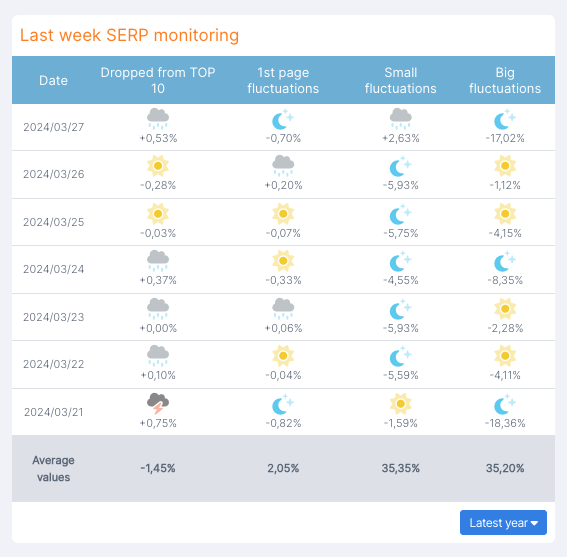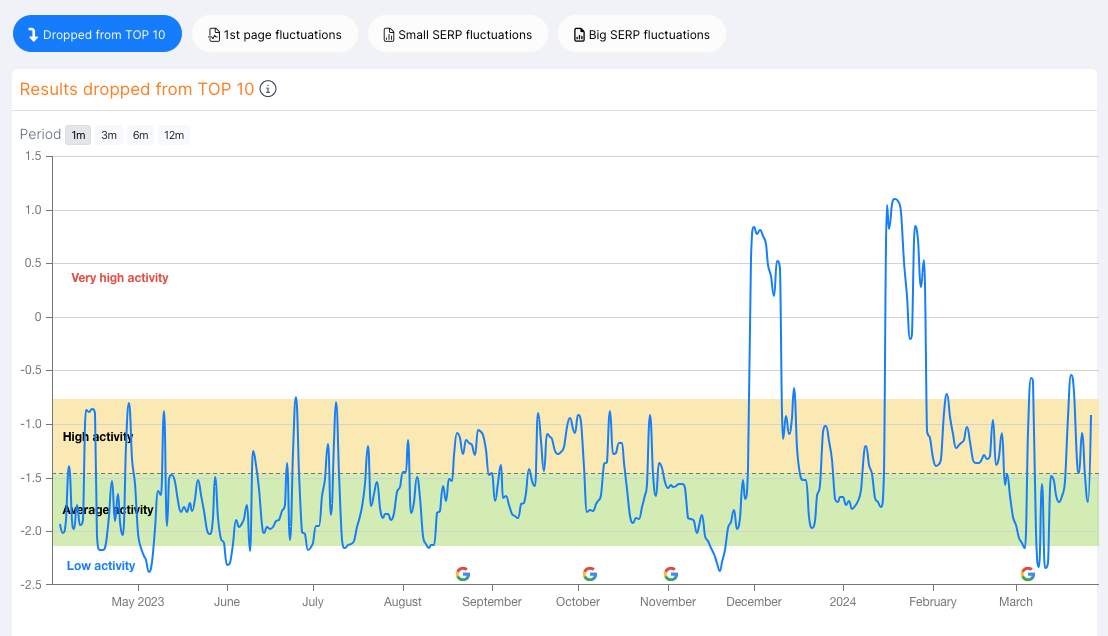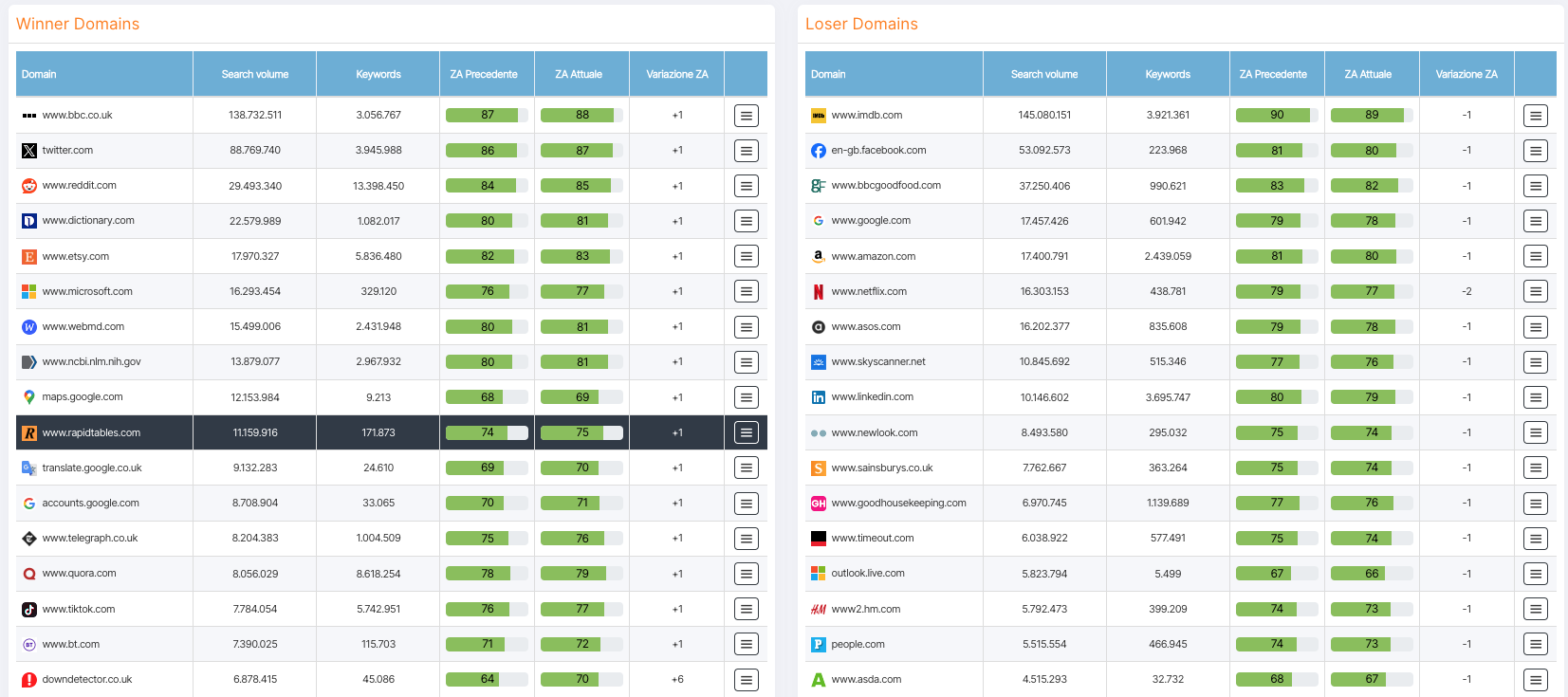SEOZoom Observatory, to always monitor SERPs and websites
Awareness is power! In the complex work of managing and optimizing a site, having up-to-date and reliable data to be able to read, interpret and use in the best way is one of the keys to succeed in achieving the desired goals. And if in general this is one of the main features of SEOZoom, it is in the Observatory section that we have an excellent representation of it. Such functions, in fact, allow us to monitor in real time the volatility of Google pages on all keywords and to follow the trend of Zoom Authority values on a large scale, so that we are never unprepared in the face of Google algorithm updates and to nip in the bud all possible variations that could affect the visibility of our site.
What is SEOZoom Observatory?
The Observatory is a specific section of our software, which provides three different tools that are updated practically in real time: Website Rankings is an overview of the top 100 most influential domain sites in Italy, as perceived by Google, divided into all the sectors tracked by SEOZoom and ranked precisely according to the level of trust they enjoy in the eyes of the search engine in each specific market niche.
The full power of data
SERP Observatory is a set of data on the pages of Google search results and on current movements, while instead ZA Observatory is a continuous focus on the distribution of all sites classified according to the Zoom Authority, the original metric of SEOZoom that objectively evaluates the quality of a domain in the eyes of Google.
How and when to use the SERP Observatory
The SERP Observatory is the ideal tool for keeping a pulse on Google’s evolutions and fluctuations in SERP rankings.
Composed by a summary table and four specific screens, the SERP observatory serves to discover at any time the variability of the first Google pages on all keywords and is ideal for controlling the fluctuations between the results caused, for example, from Google updates (and, in fact, is the tool we use for our analysis of the effects of search engine algorithmic updates).
Moreover, it can be the tool to understand whether the high variability perceived on our pages depends on external factors – updates, in fact, or other overall movements – or whether it is a matter related to our project, and then allows us to make the causes of traffic drops clearer and have a framework of information to run to cover and resume to have good results.
We can then use the observatory as a reference point for unusual movements among the results positioned on our site, to get an immediate feedback on what is happening at a statistical level on Google UK and to anticipate any market movements, so you can quickly adapt and make the most of every opportunity offered by the dynamic world of online search.
How SEOZoom SERP Observatory works
From a technical point of view, the observatory shows, at a statistical level, all the fluctuations that there have been in the SERP on Google Italy and on all other versions of the search engine included in the multilingual database of SEOZoom. The understanding of the data is quite simple and intuitive, thanks to the colorful symbols that give at a glance a piece of information about the level of movements and refer back to the classic system of “weather”.
To be precise, the tool takes as a reference an average trend of fluctuations – that is, results that enter and exit from the first page of Google – and analyzes day by day the level of deviation from this average.
Therefore, the thunderstorm symbol (dark gray cloud with lightning) and the correlating red dot in the graphs indicate that the data collected by SEOZoom signal very high activity, with significant changes within the SERPs. The second degree of this volatility is represented by the rain symbol (light gray cloud with raindrops) and the yellow colored dot, which indicate high activity, above the historical average. On the other hand, the average range is represented by the small sun drawing and the blue dots, informing us that Google’s activity is regular and the results do not deviate from the average. Finally, the clear moon icon in the table and the light blue dot in the graph are indications of moderate activity, lower than the standard percentage of fluctuations.
To make the reading even clearer and quicker, two colored bands also appear in the graphs that visually identify the standard average of variations on SERPs: the green colored one encloses precisely the average recorded level of activity, while the yellow one embraces variations toward more intense movements. In addition, the “G” symbol along the x-axis indicates times when official Google updates have been released, which may explain subsequent fluctuations.
In the tabular version, the Observatory offers monitoring of the SERPs over the last week or, by selecting from the menu provided, the last calendar year, and calculates the values of the variations compared to the average activity on Google result pages.
The tool for tracking the volatility of Google results
data are divided into 4 categories:
- Dropped from TOP 10: the frequency of variations in the first page of Google results for each keyword, with the alternation between the sites dropping from and those who are now entering in Top10.
- 1st page fluctuations: the frequency between the internal variations on the first Google page, with pages changing position while still remaining in Top10.
- Small fluctuations in SERP: daily analysis of the percentage of web pages that undergo changes in positions of slight magnitude, to identify changes in the current behavior of the Google algorithm.
- Big fluctuations in SERP: analysis of the percentage of web pages undergoing large changes, which can be considered is a continuous quality test on the performance of web pages by Google.
The same data can then also be found in the graphic representations, which extend the monitoring to a month, to have an even wider reference and thus visually discover all the continuous variations of Google.
ZA Observatory, to discover the value scale of sites
The other tool in the section is the Zoom Authority Observatory, which was created to allow everyone to instantly understand the level in which a site ranks according to our metric.
It is a strategic reference both to better understand the context in which our site moves, but also to determine whether the ZA of a domain is good or not, for example in the evaluation phase for link building activities or simple competitor analysis.
How to use the ZA Observatory
Again, we have before us a table and a graph.
The table lists 10 classes of Zoom Authority values (from 0-10 to 91-100) and immediately indicates the number of sites falling into the range and the quantitative variation compared to the previous monitoring. Moreover, if we click on the single range the graphical display opens, which goes into more detail of the distribution of domains according to the ZA score, showing the full scale.
For example, in the major ZA range from 91-100 there are currently only 4 sites – stable data; the graphical visualization shows us that, to be precise, in UK there is one site that has ZA of 98 (for the record, it is en.wikipedia.org), one that reaches a ZA of 96 (YouTube), and finally 2 sites that reach a score of 93 and 91 respectively (Amazon and Facebook).
Monitoring site performance: Winner Domains and Loser Domains
At the bottom of the tool we find two other tables that provide very useful and interesting strategic insights: Winner Domains and Loser Domains.
As is easy to guess, Winner Domains shows the list of all sites that have seen their Zoom Authority increase by at least one point since the previous survey. Conversely, Loser Domains shows all the sites that have instead lost Zoom Authority and thus organic visibility. In addition to the statistical aspect, this feature proves invaluable for doing analytical insights on domains or tracking the changes and effects caused by a Google update. ZA detections occur approximately once a month.
The usefulness of Zoom Authority
As pointed out in other insights, the ZA is a metric that is spreading increasingly for the evaluation of a site, as it is able to offer a reliable enough and useful photograph of the value of each site, looking at key issues such as organic traffic, involvement and growth opportunities.
It is a more “objective” measure and linked to the evaluations themselves of Google (and therefore not to external factors such as number of links or other variables more manipulatable), which makes the ZA also able to adapt and evolve in real time (it is not a value that “expires” or that may suffer algorithmic updates, because it always photographs the current situation).
In summary, then, the Zoom Authority measures how much Google appreciates a site: the higher its value, the more a website is positioned and the better it positions new posts. Therefore, knowing the data of the Zoom Authority of a site allows us to instantly photograph its quality, but it is only by placing it in the right context – the entire Web panorama – that we can really determine its performance.
This is ultimately the purpose of the Zoom Authority observatory, with which we can always have under control the global view of the websites in our reference database and analyze the authoritativeness of the websites on (and according to) the five versions of Google currently available in SEOZoom.








